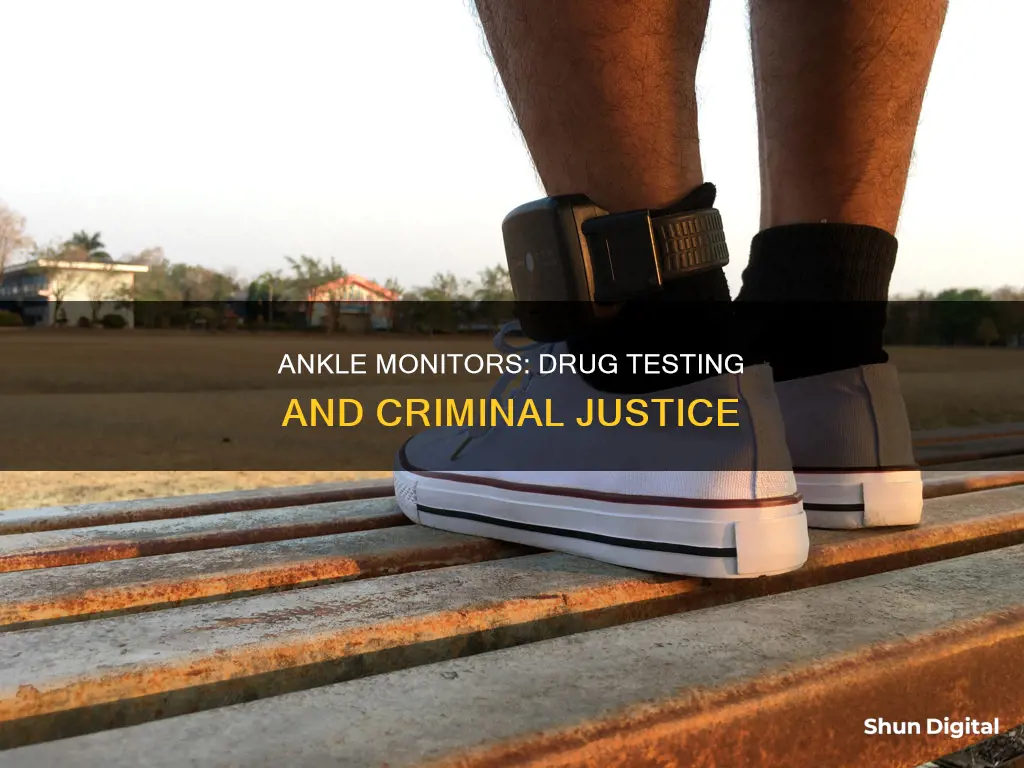
Ankle monitors are electronic devices worn by individuals under supervision, often as an alternative to incarceration or as a condition of parole or probation. While they are primarily used for tracking movements and enforcing compliance with court-imposed restrictions, some people wonder if they can also be used to detect drug use. So, can ankle monitors test for drugs?
The short answer is no. Ankle monitors, as they are commonly used, do not have the ability to directly detect drugs in a person's system. They are typically focused on monitoring movements and locations rather than conducting substance-specific tests. However, it's important to note that drug testing programs can be used in conjunction with ankle monitors to provide a more comprehensive approach to monitoring individuals at risk of drug use or relapse.
| Characteristics | Values |
|---|---|
| Purpose | Track movements and enforce compliance with court-imposed restrictions |
| Drug detection | Limited capabilities; cannot directly detect drugs in a person's system |
| Drug testing | Can be used in conjunction with ankle monitors for a more comprehensive approach |
| Components | GPS tracking, radio frequency monitoring, alcohol monitoring |
| GPS tracking | Track and monitor the movements and locations of individuals |
| Radio frequency monitoring | Establish proximity between the device and a base station installed at the individual's residence |
| Alcohol monitoring | Detect alcohol consumption through the skin |
| Transdermal alcohol monitoring | Use sensors to detect alcohol vapors released through the skin |
| SCRAM technology | Utilize a bracelet to measure the individual's alcohol consumption through perspiration |
What You'll Learn
- Ankle monitors can detect alcohol consumption through the skin
- They do not have the ability to directly detect drugs in a person's system
- Ankle monitors are used as an alternative to incarceration or as a condition of parole or probation
- They can be used in conjunction with drug testing programs
- SCRAM bracelets can differentiate between the consumption of alcohol and environmental factors

Ankle monitors can detect alcohol consumption through the skin
Ankle monitors can be used to detect alcohol consumption through the skin. Known as a Secure Continuous Remote Alcohol Monitor (SCRAM) bracelet, this device is typically worn for 30, 60, or 90 days and tests the wearer's perspiration for alcohol every 30 minutes. This non-invasive method of alcohol detection is achieved through transdermal alcohol testing, which identifies ethanol vapour (a type of alcohol found in alcoholic drinks) excreted through the skin via perspiration.
The SCRAM bracelet provides accountability and encourages compliance with court orders, resulting in higher rates of sobriety and improved community safety. It is particularly useful for individuals with substance abuse issues, offering an alternative to prison sentences. By continuously monitoring alcohol consumption, the SCRAM bracelet supports long-term behaviour change and complements treatment for alcohol dependence or addiction.
The technology behind the SCRAM bracelet is scientifically proven and unique, with the ability to differentiate between consumed alcohol and external environmental sources, such as alcohol-based products. Additionally, the bracelet is equipped with temperature and infrared sensors that can detect tampering or obstruction attempts. This ensures the integrity of the data collected, which is transmitted wirelessly to a regional monitoring centre or base station.
While the SCRAM bracelet is designed to detect alcohol consumption, it does not confirm complete abstinence. Even low alcohol consumption of 1-2 units can be detected. It is important to note that factors such as the duration of drinking, bracelet version, and age of the bracelet can impact the sensitivity of the device. Overall, the SCRAM bracelet is an innovative tool that assists in alcohol monitoring and encourages compliance with legal or treatment requirements.
The Science Behind LCD Monitors' Structural Integrity
You may want to see also

They do not have the ability to directly detect drugs in a person's system
Ankle monitors, also known as electronic monitoring devices or ankle bracelets, are electronic devices worn on the ankles of individuals under supervision. They are often used as an alternative to incarceration or as a condition of parole or probation. These devices are designed to track the movements and activities of individuals and ensure compliance with court-imposed restrictions.
While ankle monitors have various purposes, one common question is whether they can detect drugs. Ankle monitors, as they are commonly used, do not have the ability to directly detect drugs in a person's system. They are primarily focused on monitoring movements and locations rather than conducting substance-specific tests. Their main function is to ensure that individuals under supervision adhere to their assigned restrictions.
Ankle monitors consist of several components that enable their functionality, such as GPS tracking, radio frequency monitoring, and alcohol monitoring capabilities. GPS technology allows authorities to track the real-time location of individuals under supervision. Radio frequency technology helps ensure compliance with home confinement rules by establishing proximity between the device and a base station installed at the individual's residence.
Although ankle monitors cannot directly detect drugs, drug testing programs can be used in conjunction with them. These programs involve regular drug tests, such as urine or blood tests, to detect the presence of drugs in an individual's system. By combining ankle monitors with drug testing, a more comprehensive approach to monitoring individuals at risk of drug use or relapse can be achieved.
It is worth noting that advancements in wearable technology may lead to the development of ankle monitors with enhanced drug detection capabilities in the future. However, as of now, ankle monitors primarily serve as tracking devices rather than drug testing tools.
Monitoring Plex CPU Usage: A Comprehensive Guide
You may want to see also

Ankle monitors are used as an alternative to incarceration or as a condition of parole or probation
Ankle monitors are often used as an alternative to incarceration, or as a condition of parole or probation. They are used to track the movements and activities of individuals, ensuring they adhere to court-imposed restrictions. This may include restricted travel or activities, or compliance with sobriety requirements.
Ankle monitors are typically used to track an individual's location and movements, using GPS technology. This allows authorities to monitor the wearer's whereabouts and set up geo-fencing, creating virtual boundaries. Some ankle monitors also use radio-frequency technology to establish proximity to a base station installed at the wearer's residence, ensuring compliance with home confinement rules.
While not their primary function, some ankle monitors can also be used to monitor alcohol consumption. This is done through transdermal alcohol monitoring, which uses sensors to detect alcohol vapours released through the skin. Another method is SCRAM (Secure Continuous Remote Alcohol Monitor) technology, which uses a bracelet to measure alcohol consumption through perspiration. SCRAM bracelets test for alcohol every 30 minutes and can differentiate between alcohol consumption and environmental factors, such as the use of alcohol-based products.
It is important to note that ankle monitors, as they are commonly used, do not have the ability to directly detect drugs in a person's system. They are primarily focused on tracking movements and locations, rather than conducting substance-specific tests. However, drug testing programs can be used in conjunction with ankle monitors, providing a more comprehensive approach to monitoring individuals at risk of drug use or relapse.
Monitor Usage: Afterburner's Impact and Performance Revealed
You may want to see also

They can be used in conjunction with drug testing programs
Ankle monitors are often used as an alternative to incarceration or as a condition of parole or probation. They are designed to track the movements and activities of individuals and ensure compliance with court-imposed restrictions. While they are not primarily designed for drug detection, some versions do have the capability to monitor alcohol consumption.
Transdermal alcohol monitoring involves the use of sensors that detect alcohol vapours released through the skin. SCRAM (Secure Continuous Remote Alcohol Monitor) technology, on the other hand, uses a bracelet that measures the individual's alcohol consumption through perspiration. This technology tests for alcohol every 30 minutes and can ascertain a detailed pattern of alcohol consumption over a specific period, which can be used in a legal setting.
While ankle monitors cannot directly detect drugs, drug testing programs can be used in conjunction with ankle monitors to provide a more comprehensive approach to monitoring individuals who may be at risk of drug use or relapse. These programs involve regular drug tests, such as urine or blood tests, to detect the presence of drugs in an individual's system.
The combination of ankle monitors and drug testing offers a more holistic approach to addressing drug-related issues. It is important to recognise the limitations of ankle monitors and incorporate them into a broader treatment plan that addresses the underlying causes of substance abuse.
Removing Oil Stains from Your Monitor: A Step-by-Step Guide
You may want to see also

SCRAM bracelets can differentiate between the consumption of alcohol and environmental factors
SCRAM bracelets, or Secure Continuous Remote Alcohol Monitoring bracelets, are an innovative way to monitor alcohol consumption. The bracelets are fitted to the wearer's ankle and can differentiate between ingested alcohol and alcohol present in the environment, such as in perfumes or aerosols. This is because alcohol consumption will show a gradual, curved reading as the alcohol level in the body slowly increases, whereas a reading that peaks suddenly will indicate that an environmental factor has caused the result.
The bracelets test for alcohol in the wearer's perspiration every 30 minutes and are usually worn for 30, 60, or 90 days. They are waterproof, lightweight, and relatively non-invasive, allowing the wearer to go about their daily life and activities. The data is transmitted wirelessly to a Base Station twice a day, and if the wearer is not in range, the bracelet will store the information and transmit it when they are back within range.
In addition to detecting alcohol consumption, SCRAM bracelets can also detect attempts to tamper with or obstruct the device. This is achieved through temperature and infrared sensors. If someone tries to remove or interfere with the bracelet, an alert is sent to the relevant authorities, such as probation officers or the court.
SCRAM bracelets are often used as an alternative to prison sentences, particularly for first-time and non-violent offenders. They provide a way for courts to monitor offenders who are not supposed to be drinking alcohol, especially in cases involving driving under the influence (DUI). The use of SCRAM bracelets has been shown to reduce the risk of re-offending and can have a positive impact on the wearer's life, wellbeing, and behaviour.
Best Places to Buy Monitor Cleaner
You may want to see also
Frequently asked questions
Ankle monitors are primarily designed for tracking movements and enforcing compliance with court-imposed restrictions. They do not have the ability to directly detect drugs in a person's system.
Yes, certain ankle monitors incorporate alcohol monitoring capabilities. They use transdermal alcohol monitoring or SCRAM (Secure Continuous Remote Alcohol Monitor) technology to detect alcohol consumption through the skin.
SCRAM technology utilises a bracelet that measures an individual's alcohol consumption through perspiration. It takes readings automatically every 30 minutes and transmits this data to a base station.
No, individuals wearing an ankle monitor are not permitted to go through airport security.
Yes, ankle monitors can be worn during exercise. However, the wearer may want to wear a sweatband or a sock underneath the bracelet to prevent it from moving around during strenuous activity.







